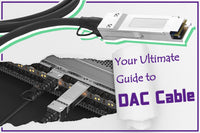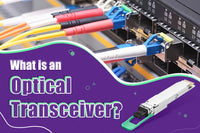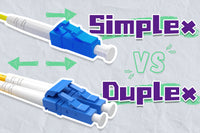Breakout cables play an important role in modern network settings. For instance, in network data centers, breakout cables enable connections between various network devices to provide different speeds and optimize performance. They are usually divided into multiple separate branch connectors that can be connected to low-speed ports, ensuring more efficient data and bandwidth distribution in network systems. This article will cover breakout cable types, their pros and cons, and everything you need to know to make decisions.
What is a Breakout Cable?
A breakout cable usually consists of a single cable with connector on one end and multiple branch cables fitted with separate connectors on the other end. The single connector is usually connected to high-speed ports, while the branch connectors connect to lower-speed ports. A breakout cable enables the connection of a network device to other devices without the need for additional cables. The main purpose of breakout cables is to facilitate network connections and simplify network management. Breakout cables are helpful for data transmission and bandwidth distribution in data centers and telecommunication networks.
What is breakout mode? The breakout mode is a configuration that can break high-bandwidth ports into several lower-bandwidth ports. For example, a 40G bandwidth can be divided into multiple smaller connection 4*10G.
Types of Breakout Cables
Breakout cables come in different types based on their constructions, materials, and applications. Network breakout cables can be mainly categorized into two types.
Direct Attach Copper (DAC) Breakout Cables
A DAC cable has modules on two sides but a DAC breakout cable typically has one QSFP module on one side and four SFP modules on the other side. Breakout DAC breakout cables are passive cables and provide a direct electrical connection using Twinax copper cables. With a fixed length, DAC breakout cables are a cost-effective solution to high-speed data transmission over short distances.
Active Optical Cables (AOC) Breakout Cables
Breakout AOC cables also have modules on two ends: one end is with a QSFP+, QSFP28, or other QSFP modules; the other end is with two or four SFP modules. AOC breakout cables combine multiple fiber optic cables into one transceiver and then divide them into separate fiber optical cables. So they can transmit data signals over longer distances. They are active cables that provide conversion from optical signals to electrical signals used for network switches or other devices. AOC breakout cables are ideal for high-density network environments.
There are also other types of breakout cables used for different application scenarios. Armored breakout cables feature a protective layer to avoid tension or compression in industrial environments; breakout plenum cables are designed for installation in ducts or air spaces to provide protection from fire hazards; and breakout riser cables are used in vertical risers or horizontal applications.
Advantages and Disadvantages of Breakout Cables
Breakout cables offer some advantages that make them ideal for some environments, but they also have some performance limitations that should be carefully considered.
- Flexible and Easy Installation: Using breakout cables can reduce the number of additional cables. In addition, it helps reduce the number of switches and other network devices, making installation and cable management easier particularly in tight or space-constrained environments.
- Efficient Data Transmission and Bandwidth Utilization: Breakout cables enable seamless connections from a single high-speed port to different lower-speed The breakout cables help manage and allocate bandwidth effectively, which is essential for large-scale network environments like data centers and enterprise networks.
- Cost Savings: Breakout cables eliminate the need for additional cables and devices like transceivers, chassis, power suppliers, and other equipment, which can help save cost on materials and installations.
Disadvantages
- LimitedScalability: The fixed branches in a breakout cable may not meet the need of future network expansion..
- Potential Signal Loss: Splitting signals among different branches may cause signal loss over long-distance transmission.
How to Choose Breakout Cables for Different Applications?
There are different types of breakout cables designed for different applications. DAC cables are easy to deploy and do not cause too much power consumption, making it ideal for high-speed connections in storage area networks (SAN) and high-performance computing (HPC) in data centers. While AOC breakout cables are ideal for transmitting high-speed data over long distances. They are suitable for storage devices in Fibre Channel storage area networks and high-density devices such as racks and cabinets. They are widely used in the telecommunication sector.
Multi-core Optical Cables: Breakout Cables vs. Distribution Cables
Both breakout cables and distribution cables are multi-core optical cables, commonly used in telecommunications and networking applications.
Breakout cables typically have fewer fibers and consist of two or more individual cables bundled around a center FRP strength member. Each fiber has its jacket, and all fibers are housed in the same outer jacket. But distribution cables can consist of hundreds of smaller fibers bundled together in the same jacket. Because breakout cables have multiple individual cables, they are less susceptible to signal interference between fibers. Although they are easier to maintain, they cost more than distribution cables. When in the vertical cabling building, breakout cables are the way to go.
Conclusion
Breakout cables have a hybrid construction with one single cable on one end and multiple cables on the other end. With this construction, they can provide efficient connections between different networks. Knowing different breakout cables along with their advantages and disadvantages can help you optimize network performance and achieve efficiency.For more information on this topic, you can keep up on our blogs. While VCELINK offers general and basic information for our customers and other visitors to the website, it’s not professional advice.



Be the first one to comment.
Leave a comment